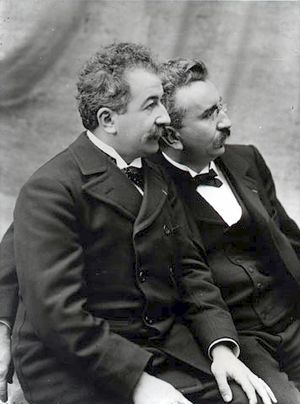Lumière Brothers
Click here for Early Movie History category page |
The Lumière Brothers were the first filmmakers in history. They patented the cinematograph, which in contrast to Edison's "peepshow" kinetoscope (1888) allowed simultaneous viewing by multiple parties.
Their first film Sortie de l'usine Lumière de Lyon ("the exit from the Lumière factory in Lyon) (1895) is considered the "first true motion picture."
History
The Lumière Brothers were born in Besançon, France to Charles-Antoine Lumière (1840-1911) and Jeanne Joséphine Costille Lumière, who were married in 1861 and moved to Besançon, setting up a small photographic portrait studio where Auguste and Louise were born. They moved to Lyon in 1870, where son Edouard and three daughters were born. Auguste and Louis both attended La Martiniere, the largest technical school in Lyon. Their father Charles-Antoine set up a small factory producing photographic plates, but even with Louis and a young sister working from 5 a.m. to 11 p.m. it teetered on the verge of bankruptcy, and by 1882 it looked as if they would fail, but when Auguste returned from military service the boys designed the machines necessary to automate their father's plate production and devised a very successful new photo plate, 'etiquettes bleue', and by 1884 the factory employed a dozen workers
It was not until their father retired in 1892 that the brothers began to create moving pictures. They patented a number of significant processes leading up to their film camera, most notably film perforations (originally implemented by Emile Reynaud) as a means of advancing the film through the camera and projector. The original cinématographe had been patented by Léon Guillaume Bouly on 12 February 1892. The brothers patented their own version on 13 February 1895. The first footage ever to be recorded using it was recorded on March 19, 1895. This first film shows workers leaving the Lumière factory.
The Lumières brothers saw film as a novelty and had withdrawn from the film business in 1905. They went on to develop the first practical photographic color process, the Lumière Autochrome.
First film screenings
The Lumières held their first private screening of projected motion pictures in 1895. The American Woodville Latham had screened works of film seven months earlier, but the first public screening of films at which admission was charged was held on December 28, 1895, at Salon Indien du Grand Café in Paris. This history-making presentation featured ten short films, including their first film, Sortie des Usines Lumière à Lyon (Workers Leaving the Lumière Factory). Each film is 17 meters long, which, when hand cranked through a projector, runs approximately 50 seconds.
It is believed their first film was actually recorded that same year (1895) with Léon Bouly's cinématographe device, which was patented the previous year. The cinématographe - a three-in-one device that could record, develop, and project motion pictures - was further developed by the Lumières.
The public debut at the Grand Café came a few months later and consisted of the following ten short films (in order of presentation):
- La Sortie de l'Usine Lumière à Lyon (literally, "the exit from the Lumière factory in Lyon", or, under its more common English title, Workers Leaving the Lumiere Factory), 46 seconds
- Le Jardinier (l'Arroseur Arrosé) ("The Gardener", or "The Sprinkler Sprinkled"), 49 seconds
- Le Débarquement du Congrès de Photographie à Lyon ("the disembarkment of the Congress of Photographers in Lyon"), 48 seconds
- La Voltige ("Horse Trick Riders"), 46 seconds
- La Pêche aux poissons rouges ("fishing for goldfish"), 42 seconds
- Les Forgerons ("Blacksmiths"), 49 seconds
- Repas de bébé ("Baby's Breakfast" (lit. "baby's meal")), 41 seconds
- Le Saut à la couverture ("Jumping Onto the Blanket"), 41 seconds
- La Places des Cordeliers à Lyon ("Cordeliers Square in Lyon"-a street scene), 44 seconds
- La Mer (Baignade en mer) ("the sea [bathing in the sea]"), 38 seconds
The Lumières went on tour with the cinématographe in 1896, visiting Brussels (the first place a movie was played outside Paris on the Galleries Saint-Hubert on March 1. 1896), Bombay, London, Montreal, New York and Buenos Aires.
The moving images had an immediate and significant influence on popular culture with L'Arrivée d'un Train en Gare de la Ciotat (literally, "the arrival of a train at La Ciotat", but more commonly known as Arrival of a Train at a Station) and Carmaux, défournage du coke (Drawing out the coke). Their actuality films, or actualités, are often cited as the first, primitive documentaries. They also made the first steps towards comedy film with the slapstick of L'Arroseur Arrosé
See also [ Georges Méliès ]
Chat rooms • What links here • Copyright info • Contact information • Category:Root
